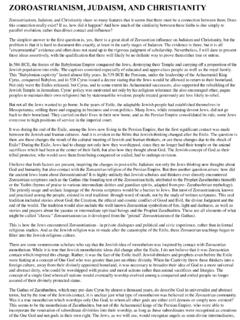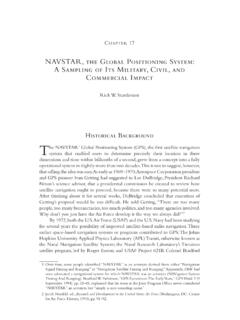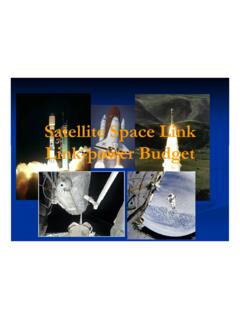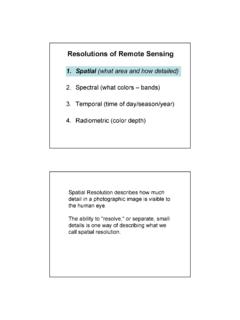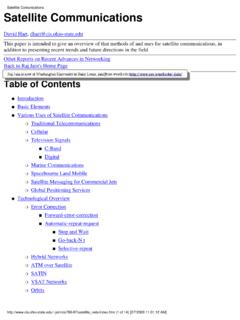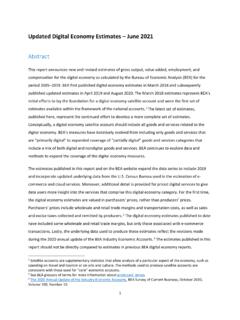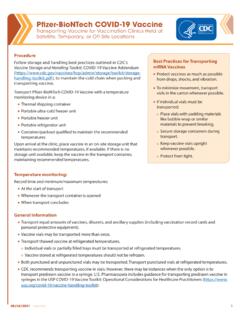Transcription of Overview of Satellite Communications
1 Overview of Satellite Communications Dick McClure Agenda Background History Introduction to Satcom Technology Ground system Antennas Satellite technology Geosynchronous orbit Antenna coverage patterns 2. COMMUNICATION SATELLITES. Uses Example Satellite systems 3. Why Satellite Communications ? Satellite coverage spans great distances A Satellite can directly connect points separated by 1000's of miles A Satellite can broadcast to 1000's of homes/businesses/military installations simultaneously A Satellite can be reached from ground facilities that move Satellites can connect to locations with no infrastructure Satellites adapt easily to changing requirements Some Common SATCOM Systems The INTELSAT system provides globe-spanning TV coverage The Thuraya Satellite -based phone system covers all of Saudi Arabia and Egypt DoD Military Communications Satellite system Links field sites with Pentagon and US command centers DirecTV, Echostar Direct-to-home TV.
2 XM Radio, Sirius Satellite radio-to-car/home Hughes VSAT (Very Small Aperture Terminal) systems Links GM car dealers, Walmart, Costco, J C Penney, etc. to their accounting centers Common Satellite Orbits LEO (Low Earth Orbit). Close to Earth Photo satellites 250 miles Iridium 490 miles Polar Orbit Provides coverage to polar regions (used by Russian satellites). GEO (Geosynchronous Earth Orbit). Angular velocity of the Satellite = angular velocity of earth Satellite appears to be fixed in space Most widely used since ground antennas need not move Circular orbit Altitude: 22,236 miles Can't see the poles 6. HISTORICAL BACKGROUND. People Early satellites Evolution 7. Historical Background: People Arthur C.
3 Clarke Highly successful science fiction author First to define geosynchronous Communications Satellite concept Published paper in Wireless World, October 1945. Suggested terrestrial point-to-point relays would be made obsolete by satellites Unsure about how satellites would be powered John R. Pierce Bell Telephone Laboratories Directed seminal work in the '50's on Communications satellites at Bell Labs Harold C. Rosen - Hughes Aircraft Company Led team that developed practical geosynchronous Communications Satellite Key contribution: spin stabilization Rotational inertia maintains pointing with small fuel requirement First geosynchronous Satellite : Syncom II July 26, 1963. 8. Historical Background: Early Communications Satellites Echo NASA.
4 First Communications Satellite (passive). 100 foot diameter metallized balloon mil Mylar polyester film Echo 1A launched August 12, 1960. Telstar built entirely by Bell Telephone Laboratories; funded by AT&T. First active Communications Satellite Launched July 10, 1962 by NASA. Low elliptical orbit (not geosynchronous). Relay built by RCA; funded by NASA. First NASA Communications Satellite ; experimental Launched December 16, 1962. First to use Traveling Wave Tube in its transponder Relay Syncom built by Hughes; funded by NASA and DoD. First geosynchronous Communications Satellite ; experimental Launched July 26, 1963. Early Bird built by Hughes; funded by Communications Satellite Corporation First commercial geosynchronous Communications Satellite Launched April 6, 1965.
5 Live via Early Bird . 9. Satcom Timeline 1950's: Navy: Hawaii Teletype Link via the Moon 1957: Sputnik 1958: SCORE. 1960: Project Westford Project Needles . 1961: Echo 1962: Telstar (spinning Satellite ). 1962: Relay . 1963: Syncom . 1965: Early Bird/Intelsat I . 1974: Intelsat IV (spinning body, de-spun' antennas). INTRODUCTION TO. SATCOM TECHNOLOGY. 11. Cellular-to- Satellite Comparison User User Cell site Ground Terminal Central office Satellite Cell site Ground Terminal User User End-to-end Satcom Picture P. h Phone Long- Satellite o haul ground system n link station e Examples: cellular, Examples: cellular plus copper, wired, wired fiber, LOS. microwave Generic Satellite components Receive Frequency Transmit Receiver Transmitter antenna converter antenna Receive and transmit Amplify weak Amplify weak frequencies must be signal; received signal different to avoid contribute little interference noise of its own P.
6 Satellite Long- h Phone ground haul o system n station link e 13. Satellite Communications Terminology 1. Ground station (also ground terminal ). sends signals to/receives signals from a Satellite 2. Modulator, demodulator (modulator + demodulator = modem). Ground station component: modulator converts digital 1 s and 0 s to a radio frequency signal (modulated carrier) that can be transmitted Demodulator recovers digital 1 s and 0 s from the modullated carrier 3. Carrier frequency The center frequency of a modulated carrier 4. Frequency band The frequency range containing the carrier frequency Satellite Communications frequency bands are standardized Within the US, the FCC defines frequency bands for satcom; coordinates specific frequency assignments.
7 Outside the US, the International Telecommunications Union has the same role 5. Frequency conversion (up-conversion, down-conversion). The process by which the carrier frequency is changed to accommodate standards or hardware limitations 6. Up-link the link from the ground terminal to the Satellite 7. Down-link the link from the Satellite to the ground terminal 14. Satellite Communications Process 1. Digital information from user arrives at a ground station . 2. Digital signal goes into a modulator, converting digital information into a modulated carrier. 3. Carrier frequency is changed (up-converted) to place it in the desired frequency range (up-link frequency band) for transmission to the Satellite 4.
8 Carrier is amplified 5. The ground station antenna radiates the carrier toward the Satellite 6. The signal passes through earth's atmosphere (~10 miles thick) and continues on to Satellite ~22,300 miles away 7. The Satellite receives signal and changes (down-converts) the carrier frequency to the down-link frequency band. 8. The Satellite amplifies the carrier 9. Amplified carrier is re-radiated toward earth through the Satellite antenna. 10. Received carrier is picked up by earth station antenna, amplified, and changed to a frequency that the demodulator can process. 11. Demodulator recovers original digital information from carrier, though not perfectly; errors are always present! 15. SATCOM GROUND TERMINALS.
9 16. Ground Terminal Transmitting Subsystem RF signal summer: f1 RF Collects signals on Modulator 1 Signal multiple frequencies Summer onto a single connector f2. Modulator 2. Input Transmitter Voice/ Antenna f3. Data Signals Modulator 3. Up-Converter Antenna: converts conducted energy into radiated energy;. focuses and directs fn signal Modulator n Up-converter: raises signal emission frequency to a range where transmission and/or filtering is realizable 17. Ground Terminal Receiving Subsystem RF signal splitter: provides multiple signals that can RF. be individually processed Signal Demodulator 1. Splitter Demodulator 2. Low-Noise Antenna Amplifier Down- Converter Demodulator 3. Antenna: Intercepts Down-converter: signal emission drops signal from space; frequency to a range converts where desired radiated energy processing (filtering, into conducted demodulation) is energy realizable Demodulator n 18.
10 SATCOM ANTENNAS. 19. Antenna Key Points One antenna talks to only one Satellite ! Antenna- Satellite association must be unique to avoid interference Small antennas have advantage of compactness, but Communications design for ground terminals with small antennas requires care to avoid interference 20. Earth Station Antenna Pointing Geometry Elevation angle 0 to 90 . Elevation axis High elevation Low elevation angle angle Local horizontal Local horizontal North North North Az = 60 Az = 210 . Azimuth axis Az = 310 . Azimuth angle 0 to 360 . 21. Antenna Geometry Focus-fed Design Advantage: simple design;. Disadvantage: distance to feed from electronics Circular Parabolic Reflector (surface accuracy related to signal wavelength).

